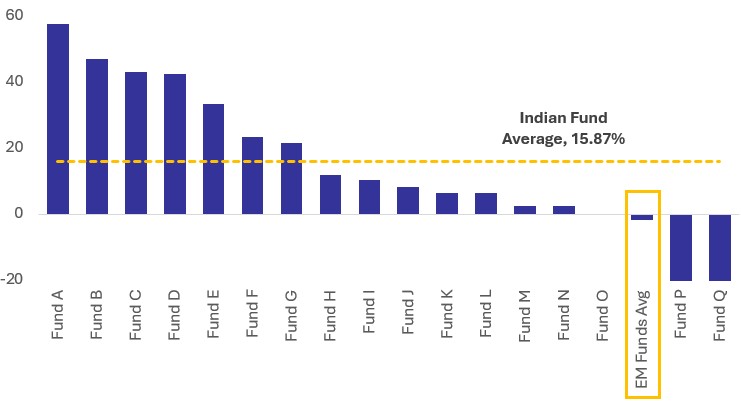Capitalising on India (Part II)
As we continue our series on navigating investment opportunities in India, we explore the advantages of partnering with local asset managers rather than relying on foreign asset managers with broader Emerging Market or Asia mandates.
Given the distinct dynamics of India’s stock market, ranging from governance frameworks and political nuances to its high-growth potential, market inefficiencies, and cultural intricacies—local expertise provides a significant edge. A deep, on-the-ground understanding allows for more informed decision-making, better risk management, and the ability to capitalise on market opportunities that may be overlooked by foreign investors.
Partnering with Local Experts
After establishing that long-term structural investing in India outperforms tactical exposure, we compared the primary investment vehicles that provide access to the Indian market: Emerging Market (EM) funds and locally managed, India-focused funds.
Our analysis reveals that EM funds have historically added limited value to their India allocations. In contrast, locally managed, India-focused funds demonstrate a much stronger environment for alpha generation. According to the S&P Global Spivacard report from June 2024, 38% of Indian fund managers have outperformed their benchmarks—significantly surpassing the corresponding rates in the US (12%) and Australia (15%).
Moreover, as shown in the table below, Indian fund managers have delivered a considerably higher average annual alpha over the past decade. This performance underscores the inefficiencies in the Indian equity market, which presents a compelling opportunity for outperformance through active, locally managed, India-centric strategies.
EM vs India Fund Alpha

It is noteworthy that the Indian stock market, represented by the Nifty 500 index (INR as of 31/08/2024), delivered an average annualised return of 12.6%. Of this, more than one-fifth of total returns were driven by alpha generated by Indian fund managers, while beta (market returns) accounted for the remaining 80%.
This breakdown further underscores the inefficiencies of the Indian equity market and highlights the significant role of active management in achieving outperformance. It reinforces the case for locally managed, India-only funds, which are better positioned to capitalise on these inefficiencies and translate them into enhanced returns for investors.
EM vs India Fund 3Y Comparison – Value Add from Stock Selection

Source: Refinitiv, as of 30/09/2024. Local India Equity Funds 3-year value-add. *EM fund performance is an average of 13 prominent EM funds (and is not reflective of any specific fund).
To delve deeper into the disparity, we analysed alpha generation by EM funds and India-focused funds over the last three years (2021–2024) during a period of strong market rally. The findings reveal that the average EM funds on average failed to generate alpha and ranked near the bottom in terms of contribution from stock selection.
In contrast, the average India-focused fund delivered a total alpha of 15.9% during the same period. This significant difference highlights the superior alpha potential of locally managed, India-focused strategies and underscores how actively managed, dedicated exposure to Indian equities can drive better investor outcomes compared to broader universes like EM mandated funds.

5 topics
1 stock mentioned
